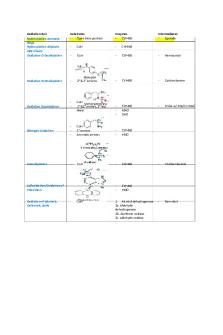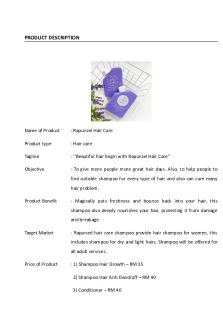MGMT 390 (phase 2) Lecture 1 - 8 PDF

| Title | MGMT 390 (phase 2) Lecture 1 - 8 |
|---|---|
| Course | Principles Of Business |
| Institution | New Jersey Institute of Technology |
| Pages | 6 |
| File Size | 70 KB |
| File Type | |
| Total Downloads | 43 |
| Total Views | 144 |
Summary
Prof. Jose Casal
Winter 2017-2018
Phase 2...
Description
W1 Lecture 1: Intro to Marketing (Ch 11) Marketing is a process: - design right products and services - setting the right price - identifying the right customers (target market) - connecting w. Customers effectively Needs, wants and demands - come from customers - demands can be measured or created Products, Services, Experiences - competitive adv. - more than just one of the 3 Exchange, Transactions, Relationships - residual, profit - relationship: series of on-going transactions Markets - competitors Value and Satisfaction - can expect future transactions Marketing v. Sales - pushing products through sales channels in hopes to make profit - marketing entices customers into consuming Changing Markets: - tech changes - connections w. Customers and suppliers - demographic and social - end of mass marketing, markets are segmented - global markets - global customers and transactions Successful Marketing - change positioning and look - broadened target market - extended product line - effective communication strategy Types
Lecture 2: Consumer Behavior (Ch 11) Factors Affecting Consumer Behavior - Cultural - culture, subculture, social class Global Markets - Social - reference groups, family, roles and status Determines lifestyle - Personal - age and lifecycle stage, occupation, economic situation, lifestyle
- Psychological - motivation, perception, learning, beliefs and attitudes VALS (Values and Lifestyles) Experiencers - buy products based on experience of it Achievers - status value of car (symbol of accomplishments) Personality Extrovert - love attention, very social Neuroticism - feeling of doom, racing thoughts Agreeable - easy to agree with avoid conflict Conscientiousness - very responsible considerate Openness - try new things Maslow’s need hierarchy Esteem - need to feel good about themselves (recognition) Social - being part of community w. Deep social ties Safety - feel confident product or service is safe Learning - Past experiences teach us things - past experience with product - assimilation of other’s experiences Buyer behavior: need recognition ---> info. Search ---> evaluation of alternatives ---> purchase decision --->purchase behavior Low product involvement: new toothpaste High product involvement: new car
Lecture 3: Corporate and Mark. (Ch 11) Competitive Adv. - positioning company to win - leveraging strength - outperforming competitors - matching competency w. Opportunity - HARD TO ACHIEVE Corporate Strategy - mission (what do we do) - business portfolio (what business are we in) - strategy (how do we win) Business Portfolio - Disney: theme parks, tv broadcasting, film, animation - NJIT: education, research, economic development Corp. and Mark. Strategies Define mission ---> setting goals ---> designing portfolio ---> plan marketing strategy Marketing Strategy - gain comp. Avantage - managing the market mix - price, product, promotion place Marketing Organization - product and brand management - marketing research - advertising and communication - new product development and testing
Lecture 4: Segmentation, Targeting ... (Ch 11) Segmentation - chop up the market to identify segment profiles Market Segmentation (choose what you want to be in) ---> Target Marketing (segments you want to be in) ---> Market Positioning (differentiate v. competitors) - geographic (by country, region within country, metro: urban, suburban, rural) - demographic (SES, family lifestyle, generation) - psychographic (social class, lifestyle, personality - behavioral (user, product benefits) Target Markets - Undifferentiated (mass) marketing - Differentiated (segmented) marketing - several market segments - Concentrated (niche) marketing - high share in one or few segments, giving up mass market - Micromarketing (local / individual marketing) Factors in choosing markets - size - growth rate - number and size of competitors - barriers to entry Positioning - gain competitive adv. In target markets - how is product better or different - why people should buy it (value proposition)
W2 Lecture 5: Promotion (Ch 13) Advertising Strategy: objective setting ---> budget decisions ---> message strategy and media strategy ---> campaign evaluation Advertising Objectives: Informative - build image or brand, explain product or service Persuasive - build brand preference Reminder - to use product Message Strategy: Positioning - Creative concept “big idea” - Meaningful, believable, distinctive (crap box v. dream car) Message Execution - Slice of Life (product in action in life) - Fantasy (Victoria’s Secret ads) - Mood or Image (Campbell’s Soup) - Humor - Testimonial - Scientific Evidence
*Safe advertising is risky* Advertising Campaign - sustained, orchestrated ad for product, brand, company - most ads are part of campaign - message: - multiple, phased execution - manage effectiveness and wear out Wear Out - people get tired of campaign, ad or concept Media Strategy - where / how the ads are placed - print - TV - Radio - Outdoor (billboards) - Internet Sales Promotional Strategies - incentivising people to use product or service - giving trials - coupon - rebates - discount - point of purchase - contests / sweepstakes Public Relations - mass promotion - press relations (ad for prius while talking about global warming) - product publicity - lobbying - community and investor relations
Lecture 6: Pricing (Ch 13) Pricing Strategies - product line pricing (high end and low end) - captive product pricing (razors) - product bundle pricing - segmented pricing - psychological pricing Cost and production - product becomes more in demand, production goes up, production cost goes down Elasticity of demand - demand drop when price goes up, customers won’t pay higher price (can do without and inelastic is like price of rent) Break even point - where product pricing and production cost are at best ratio, with best amount of profit New Products - skimming - price at premium at intro. - must be worth the price and barriers to enter - penetration pricing - low price to gain share - Ex. dell, walmart
Managing Price Changes Price Cuts - excess inventory - greater efficiency Price Increases - better product, higher costs Developing Pricing Strategies - maintain market share - maximize profits - successfully launch new products
Lecture 7: Product (Ch 12) Product Life Cycle Management: Development ---> Introduction ---> Growth ---> Maturity ---> Decline Introduction - Slow Sales and losses (start up costs) Growth - attracts early adopters and later buyers - jump in profits as costs are spread out - add new feature to fuel more growth Maturity and Decline - slowing growth, need to spur consumption (research and development, price cuts) - extend as much as possible - modify market of product Decline - changing tastes - tech advances - competition Product Portfolio Management New Product Development Idea gen. ---> concept development ---> marketing strat. ---> business analysis ---> product development ---> conventional iteration Marketing Problems / Issues - manage portfolio - alignment of corp and marketing startegies - realistic expectations - need proper marketing mix - know when to withdraw - know when and how to revise product to extend life - develop new innovative products - how to attract and retain customers - find right target markets - develop the right position
Lecture 8: Place [Distribution] (Ch 12) Marketing Channel - (network) interdependent organization, what makes the product or service available Involves channel members and relationships, w. sellers and customer Consumer Marketing Channels: Channel 1 - Producer ---> Consumer Channel 2 - Producer ---> Retailer ---> Consumer
Channel 3 - Producer ---> Wholesaler ---> Retailer ---> Consumer Business Marketing Channels: Channel 1 - Producer ---> Bus. Customer Channel 2 - Producer ---> Bus. Distributor ---> Business Customer Channel 3 - Producer ---> Manu. Rep or Sales Branch ---> Bus. Distributor ---> Bus. Customer Vertical Marketing Channels: Company owns Retailer, Producer, Wholesaler and sells directly to consumer Multi-Channel System: One producer moves through multiple channels, ie. consumer, distributors, retailers, dealers etc. Supply chain management: Supplier ---> Company ---> Resellers ---> Customers works w. reverse logistics (when customers return products)
...
Similar Free PDFs

MGMT 390 (phase 2) Lecture 1 - 8
- 6 Pages

Phase 1 and phase 2 reactions
- 8 Pages

MKT 390 - Lecture notes 1-6
- 1 Pages

MGMT 300 Lecture Notes 1
- 34 Pages

MGMT Chapter 2 - Lecture notes 2
- 12 Pages

Dreißigjähriger Krieg Phase 1-2
- 9 Pages

Test 1 MGMT - Test 1 MGMT 4150
- 14 Pages

Lecture 8 (1)(1)
- 6 Pages

Syllabus 390
- 5 Pages

Phase 2 lesson plan
- 105 Pages

MGMT week 8 - AD discussion
- 2 Pages

MGMT Chapter 8 - Prof Burga
- 1 Pages

PHASE 1: STRATEGIC PLANNING
- 1 Pages

ERD+ Phase 1 database
- 1 Pages

TRAFO 1 PHASE DAN 3 PHASE
- 13 Pages
Popular Institutions
- Tinajero National High School - Annex
- Politeknik Caltex Riau
- Yokohama City University
- SGT University
- University of Al-Qadisiyah
- Divine Word College of Vigan
- Techniek College Rotterdam
- Universidade de Santiago
- Universiti Teknologi MARA Cawangan Johor Kampus Pasir Gudang
- Poltekkes Kemenkes Yogyakarta
- Baguio City National High School
- Colegio san marcos
- preparatoria uno
- Centro de Bachillerato Tecnológico Industrial y de Servicios No. 107
- Dalian Maritime University
- Quang Trung Secondary School
- Colegio Tecnológico en Informática
- Corporación Regional de Educación Superior
- Grupo CEDVA
- Dar Al Uloom University
- Centro de Estudios Preuniversitarios de la Universidad Nacional de Ingeniería
- 上智大学
- Aakash International School, Nuna Majara
- San Felipe Neri Catholic School
- Kang Chiao International School - New Taipei City
- Misamis Occidental National High School
- Institución Educativa Escuela Normal Juan Ladrilleros
- Kolehiyo ng Pantukan
- Batanes State College
- Instituto Continental
- Sekolah Menengah Kejuruan Kesehatan Kaltara (Tarakan)
- Colegio de La Inmaculada Concepcion - Cebu
